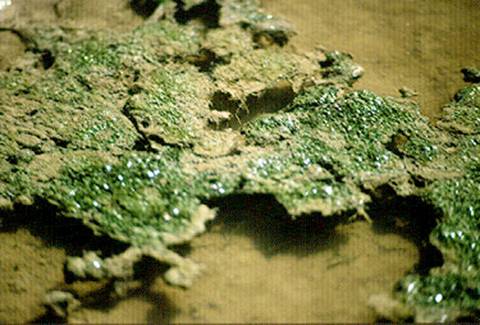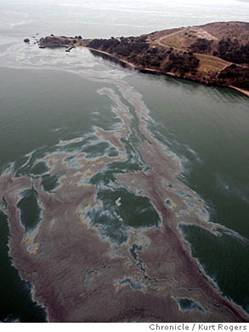A substantially updated version of the hypertextbook is available here. Please migrate to that version. This one will eventually disappear.
Liquid-Air Interfaces
Surface of Ponds

Liquid-Liquid Interfaces
Oil Drops Suspended in Water

It is fortunate that many microorganisms are capable of metabolizing hydrocarbons. Due to natural and human caused contamination large amounts of hydrocarbons are annually contaminating soil, fresh water and marine environments. Many genera of bacteria including Pseudomonas, Alcaligenes, and Flavobacterium are capable of mineralizing oil and other HCs to carbon dioxide and water. This image shows a population of bacteria actively degrading a droplet of oil suspended in water. (Needed photo)
The Effects of Placing a “Wild Type” Biofilm Producer Into Laboratory Culture.
The natural environment is a “tough neighborhood” and microorganisms have evolved entire armamentaria of mechanisms to deal with the various threats imposed by nature. Natural selection pressure maintains and hones the effectiveness of these mechanisms and effectively weeds out organisms, which fail to compete. Free-living bacteria in order to survive must avoid predation by protozoa and metazoans, avoid being washed away, resist toxic chemicals, and persist in low nutrient conditions. Pathogens produce adhesive substances by which they adhere to host tissues, they form a protective matrix which in part protects them from elements of the humoral and cellular immune system, they synthesize virulence factors which overwhelm host defenses and maintain multiple mechanisms to resist the action of antibiotics.
Bringing a biofilm-producing organism into typical laboratory culture results in a relaxation of selection. Nutrition is plentiful, adherence is unnecessary and predation is absent. In this permissive environment “wild type” organisms rapidly loose many of the characteristics, which enabled their survival in nature.
Fux et al. (2005) have shown that after as few as ten laboratory passages some reference strains have lost much of their adhesion “equipment” and perhaps as much as 37% of their genes.
This implies that using strains kept in laboratory culture for long periods of time in investigating the properties of biofilm formation is unwise as these strains may be decidedly biofilm defective.
The goal then should be to use freshly isolated strains or ones stored as freshly freeze dried cultures as soon as possible to the time of isolation.
